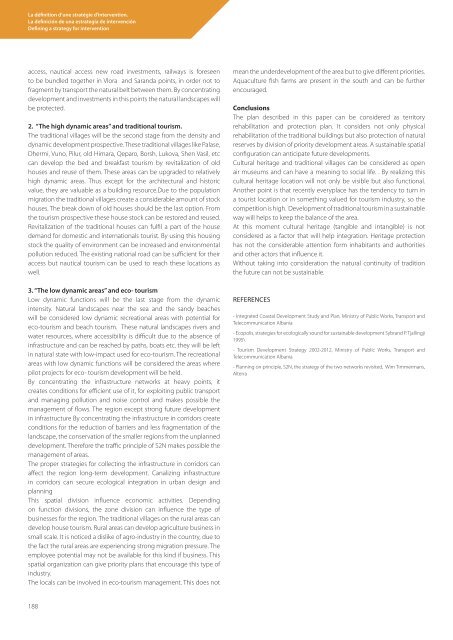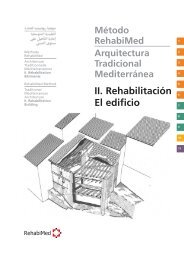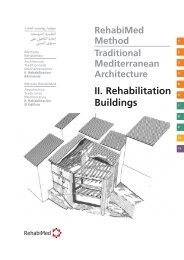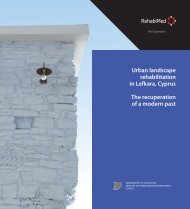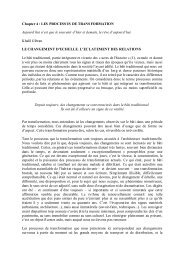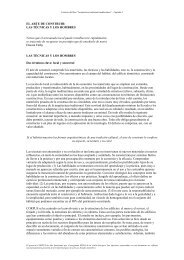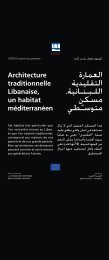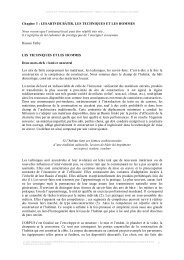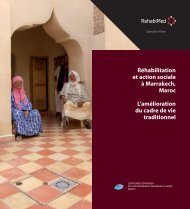La définition d'une stratégie d'intervention. La ... - RehabiMed
La définition d'une stratégie d'intervention. La ... - RehabiMed
La définition d'une stratégie d'intervention. La ... - RehabiMed
You also want an ePaper? Increase the reach of your titles
YUMPU automatically turns print PDFs into web optimized ePapers that Google loves.
<strong>La</strong> <strong>définition</strong> d’une <strong>stratégie</strong> d’intervention.<br />
<strong>La</strong> definición de una estrategia de intervención<br />
Defining a strategy for intervention<br />
access, nautical access new road investments, railways is foreseen<br />
to be bundled together in Vlora and Saranda points, in order not to<br />
fragment by transport the natural belt between them. By concentrating<br />
development and investments in this points the natural landscapes will<br />
be protected.<br />
2. “The high dynamic areas” and traditional tourism.<br />
The traditional villages will be the second stage from the density and<br />
dynamic development prospective. These traditional villages like Palase,<br />
Dhermi, Vuno, Pilur, old Himara, Qeparo, Borsh, Lukova, Shen Vasil, etc<br />
can develop the bed and breakfast tourism by revitalization of old<br />
houses and reuse of them. These areas can be upgraded to relatively<br />
high dynamic areas. Thus except for the architectural and historic<br />
value, they are valuable as a building resource.Due to the population<br />
migration the traditional villages create a considerable amount of stock<br />
houses. The break down of old houses should be the last option. From<br />
the tourism prospective these house stock can be restored and reused.<br />
Revitalization of the traditional houses can fulfil a part of the house<br />
demand for domestic and internationals tourist. By using this housing<br />
stock the quality of environment can be increased and environmental<br />
pollution reduced. The existing national road can be sufficient for their<br />
access but nautical tourism can be used to reach these locations as<br />
well.<br />
3. “The low dynamic areas” and eco- tourism<br />
Low dynamic functions will be the last stage from the dynamic<br />
intensity. Natural landscapes near the sea and the sandy beaches<br />
will be considered low dynamic recreational areas with potential for<br />
eco-tourism and beach tourism. These natural landscapes rivers and<br />
water resources, where accessibility is difficult due to the absence of<br />
infrastructure and can be reached by paths, boats etc. they will be left<br />
in natural state with low-impact used for eco-tourism. The recreational<br />
areas with low dynamic functions will be considered the areas where<br />
pilot projects for eco- tourism development will be held.<br />
By concentrating the infrastructure networks at heavy points, it<br />
creates conditions for efficient use of it, for exploiting public transport<br />
and managing pollution and noise control and makes possible the<br />
<br />
in infrastructure By concentrating the infrastructure in corridors create<br />
conditions for the reduction of barriers and less fragmentation of the<br />
landscape, the conservation of the smaller regions from the unplanned<br />
development. Therefore the traffic principle of S2N makes possible the<br />
management of areas.<br />
The proper strategies for collecting the infrastructure in corridors can<br />
affect the region long-term development. Canalizing infrastructure<br />
in corridors can secure ecological integration in urban design and<br />
planning<br />
<br />
<br />
businesses for the region. The traditional villages on the rural areas can<br />
develop house tourism. Rural areas can develop agriculture business in<br />
small scale. It is noticed a dislike of agro-industry in the country, due to<br />
the fact the rural areas are experiencing strong migration pressure. The<br />
employee potential may not be available for this kind if business. This<br />
spatial organization can give priority plans that encourage this type of<br />
industry.<br />
The locals can be involved in eco-tourism management. This does not<br />
mean the underdevelopment of the area but to give different priorities.<br />
Aquaculture fish farms are present in the south and can be further<br />
encouraged.<br />
Conclusions<br />
The plan described in this paper can be considered as territory<br />
rehabilitation and protection plan. It considers not only physical<br />
rehabilitation of the traditional buildings but also protection of natural<br />
reserves by division of priority development areas. A sustainable spatial<br />
configuration can anticipate future developments.<br />
Cultural heritage and traditional villages can be considered as open<br />
air museums and can have a meaning to social life. . By realizing this<br />
cultural heritage location will not only be visible but also functional.<br />
Another point is that recently everyplace has the tendency to turn in<br />
a tourist location or in something valued for tourism industry, so the<br />
competition is high. Development of traditional tourism in a sustainable<br />
way will helps to keep the balance of the area.<br />
At this moment cultural heritage (tangible and intangible) is not<br />
considered as a factor that will help integration. Heritage protection<br />
has not the considerable attention form inhabitants and authorities<br />
<br />
Without taking into consideration the natural continuity of tradition<br />
the future can not be sustainable.<br />
REFERENCES<br />
- Integrated Coastal Development Study and Plan, Ministry of Public Works, Transport and<br />
Telecommunication Albania<br />
- Ecopolis, strategies for ecologically sound for sustainable development Sybrand P. Tjallingji<br />
1995\<br />
- Tourism Development Strategy 2002-2012, Ministry of Public Works, Transport and<br />
Telecommunication Albania<br />
- Planning on principle, S2N, the strategy of the two networks revisited, Wim Timmermans,<br />
Alterra<br />
188


